Citrus Tree Disease
The Movie above is about citrus trees and some of the problems they face in Maricopa County it covers the identification and correction of:
- Nitrogen deficiency
- Zinc deficiency
- Manganese deficiency
- Herbicide damage
- Citrus greening
- Sooty mold
- Manganese deficiency
- Citrus gummosis
We can help with all of these problems so give us a call at (480) 969-8808.
Budding Citrus at a Glance
• Any citrus can be budded on any other citrus.
• Trees must be healthy before they can be budded.
• Budding is done in the spring or fall.
• To survive, scion buds must be pressed against the rootstock and must not dry out.
Introduction
Citrus budding is a plant propagation technique that any homeowner can do. While it does require some skill, with a moderate amount of practice a homeowner can become proficient. Once the technique is learned, homeowners can add citrus varieties of their choice to their present citrus trees. The use of budding will lead to a producing tree sooner than if a seed were planted. Also a budded tree or branch will be genetically identical to its parent. Fortunately, any citrus variety can be budded to any other citrus variety. Thus, a tangerine or lemon bud can be budded to an orange tree branch, or a grapefruit bud can be budded to a lemon tree branch, or many other combinations. The varietal bud is sometimes known as the “scion” to distinguish it from the rootstock (See below).
A tree with two or more scion varieties is known as a “cocktail tree.” These are popular when space is limited. Homeowners make cocktail trees when they bud an additional citrus variety to an established tree. Caution should be used when selecting varieties so that those with similar growth characteristics are used. For example, a lemon with a vigorous growth characteristic and a moderately vigorous mandarin should not be budded together, as the lemon would outgrow the mandarin and eventually dominate the tree. In the nursery, citrus scion varieties are not budded to other varieties but to rootstock seedlings. A citrus rootstock is a citrus variety of which the fruit is not usually consumed, but imparts compatibility to various soil types, disease resistance, yield, fruit quality or tree vigor to the variety. Most citrus trees grown today consist of a scion variety budded to a rootstock. Rootstock seeds can be ordered if large quantities are needed.
Prior to Budding
Four requirements must be met prior to budding. First, the tree that will be budded must be healthy. Water stressed trees, or trees that are weakened by disease will not support a scion bud.
Second, the bark must be “slipping”. This means that the bark must easily peel away from the wood (Figure 1). Before budding, it is a good idea to test the tree to see if the bark slips. Simply score the bark with a knife, and see if it peels away easily.
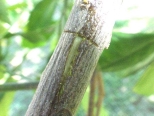 Figure 1. Bark slipping occurs when the bark may be easily peeled away from the wood.
Figure 1. Bark slipping occurs when the bark may be easily peeled away from the wood.
Bark slipping occurs in the spring and resumes in the fall in Arizona. In the winter, it is too cold, and the bark will not slip. In the summer, the temperatures are too hot. A sharp knife is the third requirement. A sharp knife will allow the propagator to cut into the wood smoothly and with minimal force. When a dull knife is used, the knife cut may be jagged, reducing the chance for bud survival. More importantly, excessive force must often be used with a dull knife, leading to loss of knife control and the possibility of injury. Finally, the propagator must have something to tie up the bud. Usually strips of rubber, such as wide rubber bands cut to 6-inch lengths are used. Tape is also used. The tape must be plastic to protect the scion bud from desiccation, and must be stretchable. Florist’s tape or Teflon tape is good for budding. Either may be found in craft or hardware stores, or in the local nursery.
Selecting Budsticks
Scion budsticks should consist of tree branches less than one year old and less than ¼ inch diameter (Figure 2). Budsticks should have dormant buds; buds that have sprouted and are actively growing are not suitable. Budwood should also be healthy; buds from sick trees may not be successful.
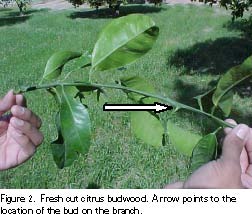 Figure 2.
Figure 2.
Budsticks may be round or angular, and should be stiff enough so that when buds are cut the tissue is not smashed. Buds should be plump and healthy, and not too closely spaced. Do not choose budwood from vigorous or extremely thorny suckers or water sprouts that arise from the tree trunk or limbs. Clip the leaves from the budwood, leaving the petioles (leaf stems) intact. The petioles provide convenient handles that can be used to hold a bud when it is cut from the budstick. In some cases, small thorns can be used in place of petioles as a handle.
Storing Budsticks
Since budsticks must have dormant buds, they must often be collected prior to bark slip and stored. Budsticks may be stored for 3 to 4 weeks until needed. Simply wrap the sticks in wet paper towels and insert the bundle in a plastic bag. Close the bag and store in the refrigerator at 35 to 45°F. Be sure that the budsticks do not freeze.
Selecting and Preparing the Budding Location
The budding location may be on a rootstock (citrus seedling) or on a mature tree branch or stem. The stem or branch diameter should be between ½ and ¾ inch in diameter. It is best not to choose a location that is directly exposed to light from the south or west, or a location that is in permanent deep shade. Either extreme may lead to scion bud failure. To prepare the budding location, make a horizontal cut on the stem of the rootstock (Figure 3). The cut should be deep enough to insure that the bark will peel away from the interior wood. The “T” is then made by a vertical cut (Figure 4). The bark is carefully peeled from the stem of the rootstock exposing a “pocket” into which the scion bud can be placed. Care should be taken not to tear the flaps of bark in the process of spreading them.
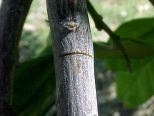 Figure 3. Horizontal cut on the rootstock.
Figure 3. Horizontal cut on the rootstock.
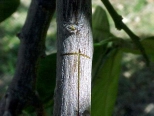 Figure 4. Vertical cut on the rootstock.
Figure 4. Vertical cut on the rootstock.
If the bark does not slip easily, this indicates that the stock is not undergoing active growth and budding should be conducted later when active growth has resumed.
Cutting the Bud
Select a plump dormant scion bud from the budstick. Make a perpendicular cut across the budstick about ½ to ¾ inch above the bud (Figure 5). Cut the bud and a small piece of the wood underneath it from the budstick using a continuous pushing motion (Figure 6). The cut should begin about ½ to ¾ inch below the bud, and should go deep enough into the wood so that when the cut is finished at the perpendicular cut, the bark and the small piece of wood will separate from the bud stick. It is best not to make an additional cut to separate the bud from the budstick. Use the leaf petiole as a handle. Avoid touching the flat side of the bud with the fingers. Oil from the hands may impair the connection of the bud to the rootstock.
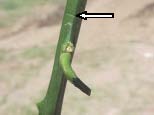 Figure 5. A perpendicular cut above the bud. Notice petiole “handle.”
Figure 5. A perpendicular cut above the bud. Notice petiole “handle.”
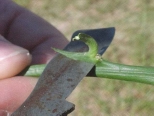 Figure 6. Cutting under the Bud with the knife.
Figure 6. Cutting under the Bud with the knife.
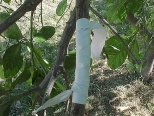 Figure 8.Bud completely wrapped in tape.
Figure 8.Bud completely wrapped in tape.
Inserting the Bud in the T Cut Forcing the Bud
Carefully slip the scion bud beneath the bark flaps. Push When the shoot on the living bud grows, the bud is the bud down into the pocket so that the flaps cover the “forced” (Figure 9). For spring budding, this should occur bud completely, and the bud fits tightly within the pocket immediately, while for fall budding, the living scion bud (Figure 7). Orient the bud in the same direction that it was remains dormant until the spring. All emerging shoots oriented on the budstick. within 1 inch above and below the new bud should be
removed by hand as soon as they appear.
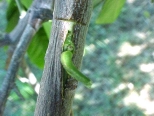 Figure 7. Bud in pocket.
Figure 7. Bud in pocket.
 Figure 9. An expanding bud.
Figure 9. An expanding bud.
Wrap the entire area with tape or rubber band strips being careful to not leave any area of the bud exposed (Figure If the bud remains alive, but no shoots appear, then the bud 8). The bark flaps will be held tightly against the bud by the must be forced artificially. Three methods are common. The rubber strips or tape. This will allow the bud to remain best method is to make a shallow horizontal cut in the bark moist and will allow for contact between the cells of the about ½-inch above the inserted bud. This should favor shoot bud and rootstock that must occur for the bud to survive. Growth from the bud at the expense of competing shoots. An Remove the tape or rubber strips 2 to 3 weeks after bud-alternative is to bend the rootstock just above the inserted ding. If the scion bud is green it is alive. If not, try again. bud. If neither of these two methods works, the rootstock branch should be cut off about 1 inch above the living bud.
A Little Science…
Between the bark (periderm) and the wood of trees, lies a layer of cells called the vascular cambium. From this layer grows the wood, or xylem to the inside and the phloem to the outside. Both xylem and phloem are important tissues that conduct water, nutrients and sugars.The cells that arise from the cambium can intermingle and form connections if they are adjacent. The objective of budding is to align the cambium layer of both rootstock and bud as closely as possible.Thus, it is important that the bud is removed from the budstick with a smooth cut, and the bud and rootstock be tightly pressed together.
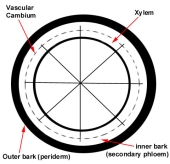
ISSUED FEBRUARY 2000 BY:
Glenn C. Wright
COOPERATIVE EXTENSION
THE UNIVERSITY OF ARIZONA
College of Agriculture, P.O. Box 210036 • Tucson,Arizona 85721-0036
We currently serve - Mesa – Gilbert - Tempe - Chandler Arizona - Scottsdale – Paradise Valley - East phoenix.
Warners Tree Surgery tree surgon
expert tree disease diagnosing diagnosis treatment
help old citrus trees,help Sick Queen Palms
tree fertilizing deep root fertilization
soil treatment mycorrhizal fungi
Mesa Gilbert Tempe Chandler Arizona Scottsdale Arizona
Help sick trees phoenix
Sick queen palms tree doctor surgeon
Brown leaves discolored leaves dead leaves
Sap sapping tree leaves leaf insect
sapping mesquite tree insects leaf leaves
soil treat treatment root treatment
tree service tree trimming tree removal
fungus dead tree top tree freeze